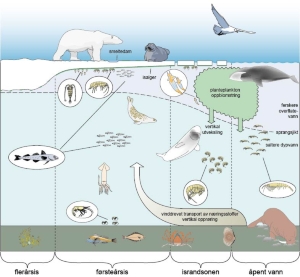The Poles – canaries in the mineYesterday we called on the Chilean Antarctic Institute. Our visit was both pleasant and useful: we were shown around and given a thorough introduction to their research. They are interested in many of the same issues as we are.
“Thick fog. Stiff breeze from SE. Snowing and snowdrift. It was not a good day for travelling.”– Amundsen on this day 100 years ago (Read more …) 
Paradoxically, it is in the coldest parts of the world that climate changes start earliest and are strongest. Just like the canaries that were formerly used to warn of high levels of poisonous gases in coal mines, the polar regions are now warning us about a warming trend that will have an increasingly strong impact in other parts of the globe. Global temperature is rising, but the increase is not evenly distributed. Some places are warming less than average, whereas others – called “hot spots” – are warming more. At Faraday Station on the Antarctic Peninsula, the temperature has increased nearly 3°C in the last 50 years. That is about five times the global average. There is a striking similarity between what is happening on the Antarctic Peninsula and in the Svalbard/northern Barents Sea area. In both places, warming has led to less sea ice and major changes in the ecosystem. While the penguins wander southward in Antarctica, ice-dependent animals such as ringed seals and polar bears head northward in the Arctic. In the south, floating ice shelves have collapsed; in Svalbard, glaciers are retreating so quickly you can almost see it happening. At the Norwegian Polar Institute’s centre for Ice, Climate and Ecosystems (ICE) researchers examine how endemic ice-dependent species adapt to a warmer Arctic. What happens to the reproduction and migration patterns of polar bears? Will a northward retreat of the ice edge impair the health of ivory gulls, impair their reproduction, and force them to patrol larger territories to find food? The researchers have many questions and few answers. More knowledge is needed. We may see dramatic changes – “tipping points” – for arctic marine ecosystems when the ice retreats so far north that it no longer covers the continental shelf in the summer, and when the multi-year ice disappears. But even before then, the animals that inhabit the Arctic will face gradual change.
Did you know that Antarctica is reserved for peace and research?
Antarctica is the only continent in the world where there has never been an armed conflict. To gain admission into Antarctic cooperation, a nation must actively carry out research there. |
South Pole 1911–2011 is an informational outreach project run by the Norwegian Polar Institute
Contact person:


